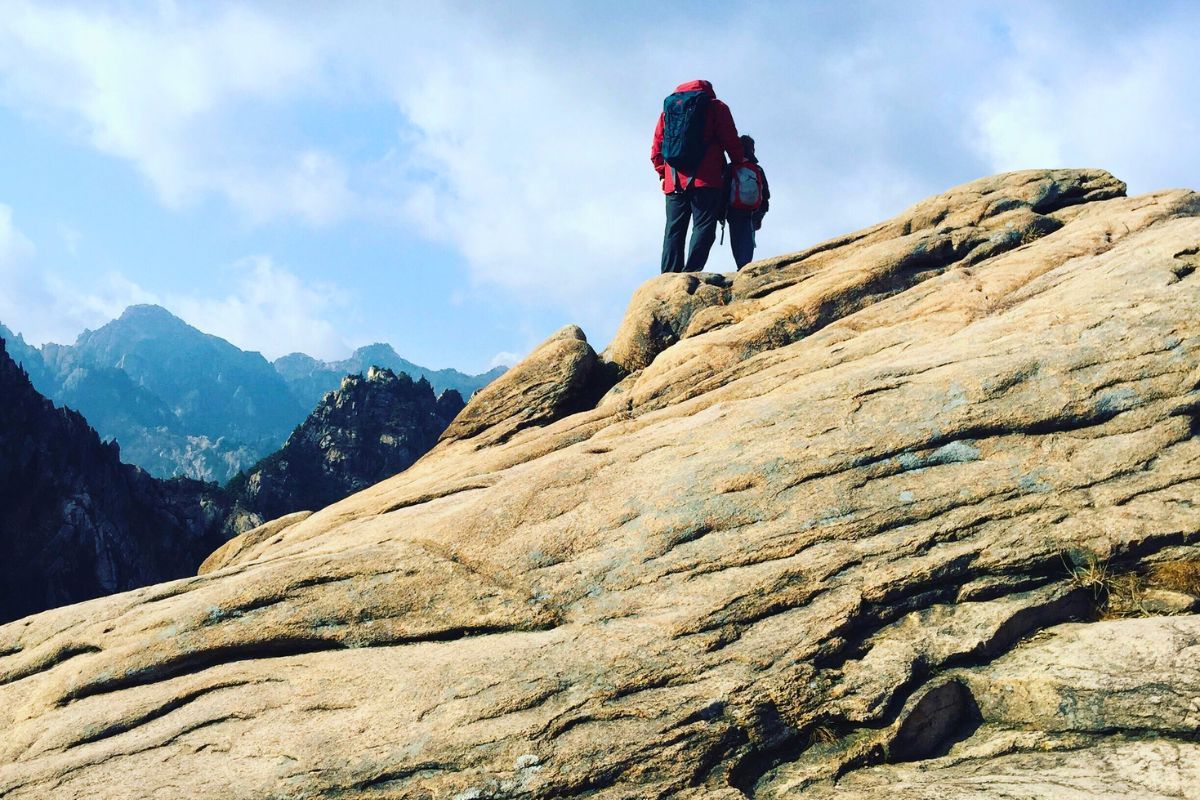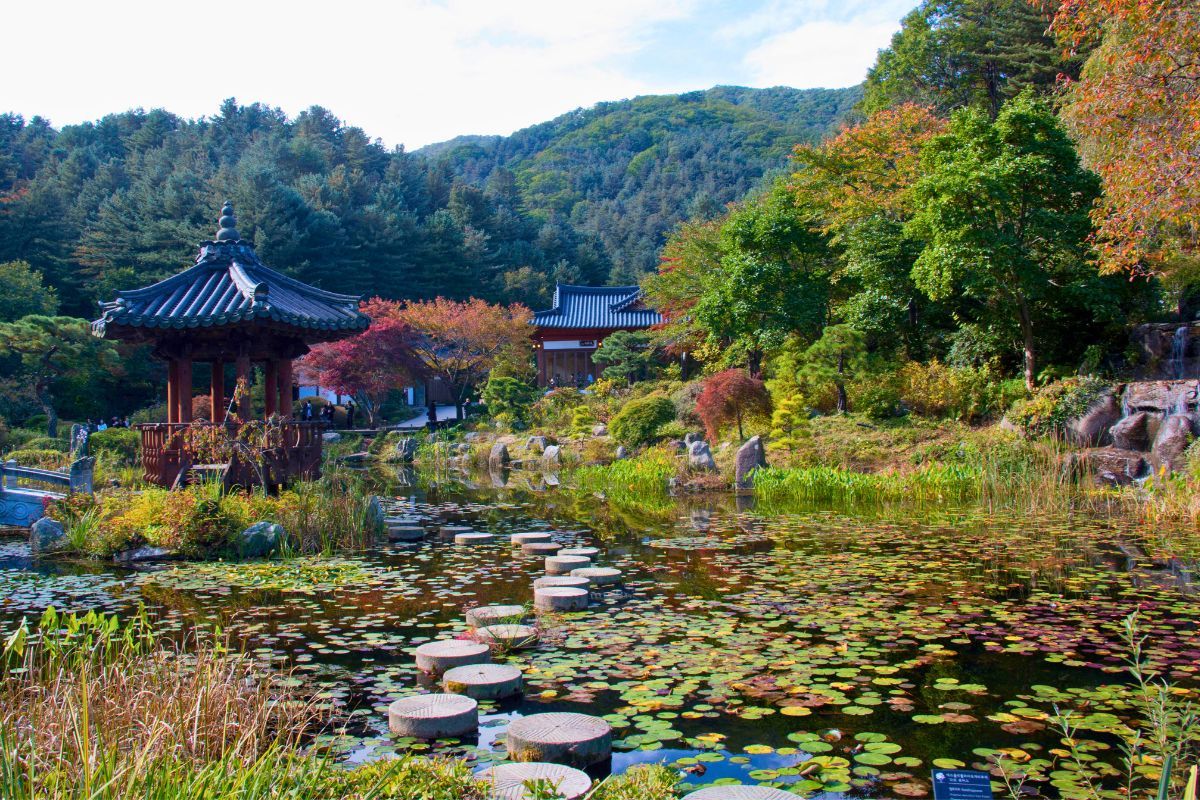Seoraksan National Park: Day Trips and Tours from Seoul
Seoraksan National Park is a beautiful nature reserve located in South Korea. The park is home to several mountain peaks, the tallest about 1700 meters above sea level. The reserve also holds thousands of species of rare plants, creating a lush backdrop with its flora and fauna.
Take a day trip to Seoraksan from Seoul to escape the hustle of the city and become immersed in the natural beauty of South Korea.
Seoraksan National Park is a beautiful nature reserve located in South Korea. The park is home to several mountain peaks, the tallest about 1700 meters above sea level. The reserve also holds thousands of species of rare plants, creating a lush backdrop with its flora and fauna.
Take a day trip to Seoraksan from Seoul to escape the hustle of the city and become immersed in the natural beauty of South Korea.

(0/24) checking Musement...
Seoraksan National Park is a beautiful nature reserve located in South Korea. The park is home to several mountain peaks, the tallest about 1700 meters above sea level. The reserve also holds thousands of species of rare plants, creating a lush backdrop with its flora and fauna.
Take a day trip to Seoraksan from Seoul to escape the hustle of the city and become immersed in the natural beauty of South Korea.

Here's all you need to know about Seoraksan, one of the most exciting day trips from Seoul.
How to get to Seoraksan National Park from Seoul?
Seoraksan National Park is located on the eastern side of South Korea bordering the Sea of Japan.
From Seoul to Seoraksan National Park by car
Seoraksan National Park is about a 3-hour drive east of Seoul. You’ll leave the city center and head east on Highway 60 for the majority of the ride. Once you near the nature reserve you’ll merge onto Highway 44/46 for the final bit of the journey.
From Seoul to Seoraksan National Park by bus/public transport
The bus from Seoul to Seoraksan takes about 2.5 hours, costs around €30 and leaves the city about every 20 minutes. Head to the East Seoul Bus Terminal to board the bus and begin the journey. You’ll be dropped off at the nearby town of Sokcho where you can either call a taxi for the final 15 minutes or board a local bus running to the National Park.
Guided tour to Seoraksan National Park from Seoul
The easiest way to visit Seoraksan National Park from Seoul is with a guided tour that includes roundtrip transportation. These day trips typically last around 12-14 hours and include pickup and drop-off to and from either a meetup spot or your accommodations in Seoul.
How much does the entrance ticket to Seoraksan National Park cost?
Entrance tickets to the Seoraksan National Park cost about €4 per adult between the ages of 20 and 65, about €2 per youth between the ages of 14 and 19 and less than €1 per child between the ages of 8 and 13. All children under the age of 8 and all seniors over the age of 65 are able to enter the park for free.
The Gwongeumseong Cable Car is one of the most desired attractions at the reserve, and tickets to ride come at an additional cost. For all individuals in middle school or older, a roundtrip ticket on the cable car costs about €8 per person. For children who are in preschool, kindergarten or elementary school, a roundtrip ticket costs about €5 per person. Children 36 months and younger are able to ride the cable car for free.
What is the typical itinerary?

A typical day trip to Seoraksan National Park from Seoul begins with a morning hotel pickup. Once you arrive at the reserve, you’ll have plenty of time to hike and climb mountain trails either with a guide or in your own free time.
Many tours visit the park’s beautiful landmarks such as the historic Shinheungsa Temple, while some will include a ride on the Gwongeumseong Cable Car. The cable car takes riders to the top of the mountain summit for a panoramic view of the park below.
Specific tours visit Naksan Beach, and some will pay visits to Nami Island and the Garden of Morning Calm. After a full day of exploration, your tour guide will transport you back to Seoul for a hotel drop-off.
What kinds of tours are available to go to Seoraksan National Park?
Guided tour to Seoraksan National Park from Seoul in Autumn

This tour only operates in the fall as it explores Seoraksan National Park when the flora and fauna have transformed into the warm colors of autumn.
This day trip begins with an early morning pickup at a meeting point in Seoul. Once you join your guide, you will travel for about 3 hours by bus until you arrive at the mountainous Seoraksan reserve.
You’ll begin with an exciting hike through the breathtaking landscapes, taking in the vibrant fall colors as you go. You can leisurely stroll the area or enjoy some of the more intense hikes depending on your experience level.
Learn about the park and the ecosystem of South Korea as you breathe in the clean mountain air. You’ll have plenty of time to take photos before returning to Seoul with the help of your guide.
Private tour to Seoraksan National Park from Seoul

This private day trip to Seoraksan National Park visits both the outer and inner portions of the reserve and can be completed during any season of the year.
You’ll begin with a hotel pickup where you will join your guide for the 3-hour ride east. Once you are near the National Park, you’ll stop at the Misiryeng Pass to catch views of inner Mount Seorak before heading to Jujeongol Valley.
Your group will then have the chance to hike the valley, deep beneath the mountain ridges. Depending on the time of the year, the flowers might be blooming or the fall leaves might be bright orange and red.
During the hike, you’ll visit Yongso Waterfall and later experience the famous fizzy natural mineral water of the Osaek River.
Next, you’ll head to Naksan Beach, one of the best in the Gangwon-do region. You’ll have the option to visit both the Naksansa Temple and Uisangdae Pavilion before heading to a traditional Korean lunch.
The journey concludes with a visit to Sogongwon Park where you’ll board the Seorak Cable Car up to the Gweongumsung Peak for views of the East Sea. You’ll be amazed at the heavenly scenery on the way to the top. Marvel at the massive bronze Buddha statue at Shinheungsa Temple before making your way back to Seoul.
Hiking tour to Seoraksan National Park from Seoul

Seoraksan National Park is known for having nearly 400 square kilometers of hiking trails.
The best way to see as much of the park as possible is with a hiking tour from Seoul.
This private day trip begins with an early morning hotel pickup from where you’ll make your way to the National Park in an air-conditioned vehicle. Once you arrive, you’ll begin your expansive hike of the reserve, over massive peaks, gushing waterfalls, imposing temples and magnificent views.
On this 12-hour tour, the main attraction is a visit to the park’s famous Dinosaur Ridge, named for its likeness to the extinct creature’s spiked back. This tour is for experienced hikers only as the difficult up and down of Dinosaur Ridge takes about 10 hours to climb.
Guided tour to Seoraksan plus Nami Island and Garden of Morning Calm

This guided tour from Seoul combines several of South Korea’s most majestic destinations in one day trip.
After a morning departure from Seoul, you’ll stop first at Seoraksan Mountain. Embrace the dazzling rock formations and lush wildlife in the UNESCO-listed reserve.
Next, you’ll head to the historic Shinheungsa Temple and enjoy a thrilling ride up the cable car to the mountain summit for panoramic views below.
Follow the ride with a hike through the Jujeongol course to see the lush landscapes of the National Park on foot.
Afterward, you’ll head to Nami Island, a heavenly destination with scenic walkways and tranquil photo spots.
This tour finishes with a visit to the Garden of Morning Calm, fantastically landscaped grounds filled with oriental mystique. Afterward, you will journey back to Seoul for drop-off.
How much does a day trip to Seoraksan National Park from Seoul cost?
An autumn full-day tour of Seoraksan National Park from Seoul costs about €60 per person. A private excursion that visits both inner and outer Seoraksan costs about €350 per person. Tours that cater specifically to experienced hikers are priced around €370 per person, while a combination day trip that includes a visit to Nami Island and the Garden of Morning Calm costs about €100 per person.
What will you see and do?

Seoraksan Mountain
Seoraksan Mountain is the highest peak in the Taebaek range of eastern South Korea. The summit is the centerpiece of Seoraksan National Park and is surrounded by the flourishing vegetation of the reserve. The mountain is encompassed by many hiking trails and you can reach the top by taking a ride on the Gwongeumseong Cable Car for spectacular panoramic views.
Jujeongol Valley
The Jujeongol Valley is famous for its beautiful fall colors that arrive each autumn, as well as the incredible rock structures that frame the water below. The name of the valley originates from the Joseon-era bandits that were said to have settled in the area, using counterfeit coins to make their living while disguised as Buddhist monks. There is a trail through the valley that leads to Seongguksa Temple.
Osaek Mineral Spring
This river and springs are known for producing fizzy carbonated water, making it one of the most popular destinations for health benefits. Though the water is about 27 degrees Celsius and smells like Sulphur, the water is high in iron and carbonic acid which helps with digestion and good blood flow.
What are the opening times?
Seoraksan National Park is available to visit all year round. The nature reserve is open every day from 6 AM until 8 PM, and the cable car runs up and down the mountain from 9 AM until 6 PM.
When is the best time to visit Seoraksan National Park?
Autumn and spring are arguably the most popular times to visit Seoraksan. The fall foliage in the park is breathtaking, with vibrant shades of red, orange, and yellow. The weather is also cool and pleasant for hiking. While in spring the park bursts into life with cherry blossoms, azaleas, and other wildflowers.
What other day trips can you do from Seoul?
- Demilitarized Zone day trip from Seoul
- Petite France day trip from Seoul
- Gangchon day trip from Seoul
- Suwon Hwaseong Fortress day trip from Seoul
Travel tips
- Especially during peak seasons, arriving early can help you avoid crowds and secure parking if you're driving.
- Wear appropriate hiking shoes or boots, as the trails can be challenging in certain sections.
- Stick to designated paths to minimize ecological impact. Do not litter, and be mindful of the local flora and fauna.

